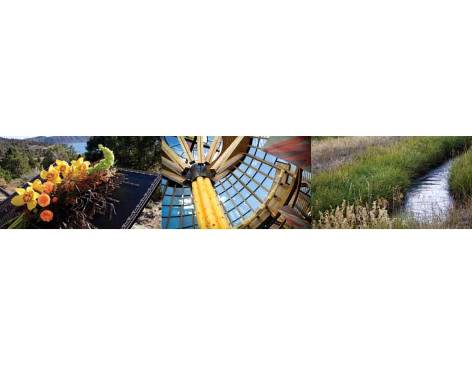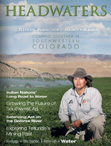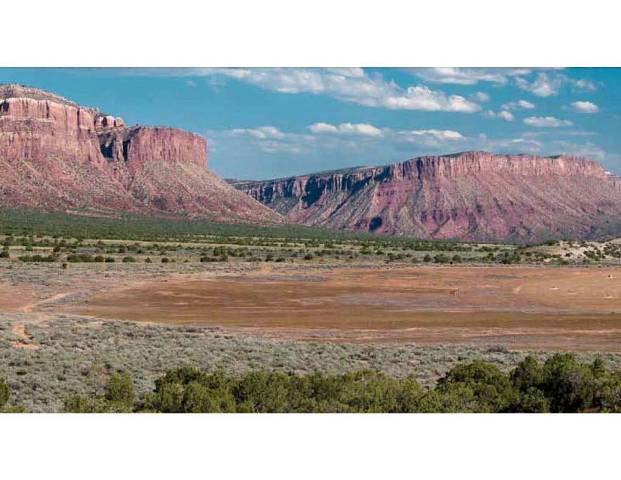For Colorado's two Indian tribes, the long-awaited promise of water fulfilled at last, brings hope for continued economic growth

by Gail Binkly
Manuel Heart remembers the days before the Dolores Project brought drinking water to the Ute Mountain Ute Indian Reservation in far southwestern Colorado and northern New Mexico. “We had a water truck going to Cortez and filling up two, three, four times a day. It would go around the community, and whoever had their water jugs out would get them filled up,” recalls Heart, a member of the Ute Mountain Ute tribal council who has served as tribal chairman, vice chair, treasurer and secretary. “It was like a Third World country. We had electricity but no plumbing. A lot of people would go to Cortez to do laundry or even take showers.”
Even 20 years ago, the 910-squaremile reservation south of Cortez had little commercial activity. There were two small farms plus a sewing factory and a pottery factory. Tourists driving past the turnoff to the reservation on Highway 160/491 saw mainly clumps of grass and rabbitbrush.
But when the Dolores Project brought water to the Ute Mountain Utes in 1994, the reservation blossomed like the desert after a spring rain. Today it is home to a thriving casino and restaurant, a 90-room hotel, a truck stop/travel center, an RV park and a 7,700-acre farm. The Ute Mountain Utes are the largest employer in Montezuma County, providing some 1,580 jobs. Their Weeminuche Construction Authority is a major firm in the area and
helped build the 47-mile canal to bring Dolores Project water to the reservation from Cortez.
“It did really boost the Ute Mountain Ute Tribe,” says Heart. “Now we have treated, running water all the way from the Cortez treatment plant.”
And with the completion of the $513 million Animas-La Plata Project near Durango— also built by the Weeminuche Construction Authority—the Ute Mountain Utes and the Southern Utes adjoining them on the east have each gained an additional 33,050 acre feet of the West’s most precious resource. But it was a long and tortuous path to obtaining that water.
A Tribal Right
Around 1300 A.D., shortly after the Ancestral Puebloans had left the Four Corners area and scattered to regions farther south, the native peoples now known as the Utes were a loose confederation of 13 huntergatherer bands roaming some 130,000 square miles of Colorado, eastern Utah and
northern New Mexico. When the Spanish arrived with their horses in the late 1500s, the Utes swiftly became master horsemen and achieved even greater dominion over the region through their new mobility. But with the inexorable expansion of white settlers into the West, the Utes were eventually forced to give up the largest and best portions of their territory and were squeezed onto three small reservations, one in northeastern Utah. The two reservations within Colorado, the
By Caitlin Coleman
The small town of Pagosa Springs is named for its claim to fame: the largest and deepest hot springs on the planet. The springs provide a tourist draw—and a renewable energy source. Since 1982, the town has operated a geothermal heating system, supplying hot water used for space heating to 13 commercial and two residential customers, including local schools, churches, a bank and the jail. Still, residents of Pagosa hope to do more, like use thermal energy for additional space heating, to warm a system of greenhouses, to develop a fish hatchery, maybe to create a botanical education program—maybe.
“We’re trying to look at the resources we have here—of course geothermal is one,” says Phil Starks, sanitation supervisor for Pagosa Springs. At the town’s bidding, students from the Colorado School of Mines in Golden and researchers with the Frisco-based Geothermal Management Company are conducting a feasibility study this year to determine whether Pagosa’s hot springs can be further developed and to identify the degree of additional
energy that could be obtained.
One concern researchers will evaluate is whether additional development could deplete the springs or cause decreases in pressure that would impact existing geothermal users. Provided the researchers find that is not the case, they will suggest additional ways to make use of the water, most likely
for additional space heating, aquaculture or agribusiness, says consultant Gerry Huttrer with the Geothermal Management Company.
A positive outcome would please the Geothermal Greenhouse Partnership, a group that’s been working to engage the community and obtain land, water and funding to build greenhouses where residents can grow food, educate their children and attract tourists. “We do feel that this is something the community will take pride in— it will highlight this great resource,” says Kathy Keyes, a founding member of the partnership. “It’s an intrinsic resource that we can use to further ourselves.”
Southwestern Colorado's Food Future
By Jesse James McTigue
 Scott Mahaffey represents a diminishing demographic; he’s a third-generation farmer in southwestern Colorado’s Montezuma County. Much has changed in agriculture since his father Joe farmed the family land, and then again, much has stayed the same.
Scott Mahaffey represents a diminishing demographic; he’s a third-generation farmer in southwestern Colorado’s Montezuma County. Much has changed in agriculture since his father Joe farmed the family land, and then again, much has stayed the same.
Back in Joe’s day, it was common for grown children to take over the family farm and land was affordable. Joe and his two brothers assumed ownership of a 320-acre farm from their father, later expanding to 2,200 acres. They were dryland farmers, producing beans, wheat and hay on unirrigated land.
That changed 25 years ago when the Dolores Project, an irrigation initiative including the creation of a reservoir, canal system and pumps, gave the Mahaffey farm access to water. Joe and his brothers divvied up the family land—Joe negotiated a 1,000-acre parcel—and on July 13, 1987, they turned on the spigots. Joe’s yields went from two tons of alfalfa per acre to five tons, 300 pounds of beans per acre to 2,000 pounds.
Today, Scott farms his father’s 1,000-acre parcel, still producing alfalfa, beans and wheat, citing the alfalfa, sold mostly as dairy hay, as the most profitable crop. With irrigation plus conservation farming methods, Scott can more consistently rely on greater yields.
“I rotate my crops according to what that ground needs to stay healthy and produce what it can,” Mahaffey says. “If beans have a high price one year, I can’t just plant a bunch of beans because of the high price. I have to put in the ground what it needs to stay fertile for years and years to come.”
Montezuma County is known for its dryland bean production—a commodity the county has historically, and currently, produced in the top 1 percent nationally. At present, the region’s most profitable export crop is dairy hay, or alfalfa, which is typically exported to farms in Texas. Beef cattle, lambs and hay are also staples of regional farms and ranches.
The Mahaffeys and other like-minded growers may have adopted conservation methods, but according to Judy Garrigues, district manager for the Dolores Conservation District, most commodity crop farmers still use traditional farming methods that are hard on the land. Farmers often rely on
chemical-based fertilizers, instead of crop rotation or cover, to increase the land’s yield, which doesn’t promote the bacterial activity necessary for healthy soil in which plants can truly thrive, says Garrigues. And dated practices, such as fallowing a field without protective crop cover, make the soil susceptible to erosion when high winds rise.
In addition to questions of ecological sustainability, regional leaders are concerned that many family farms, under pressure from development on land and water resources, will simply be lost, or sold off, as the older generation retires.
In November 2011, 60 food producers, buyers, conservation groups and community members gathered for the Southwest Food and Farmland Forum to identify challenges, opportunities and solutions for securing regional agriculture. They determined protection of irrigated agricultural lands, education and support for new farmers, establishment of local food markets, and circumvention of distribution obstacles to be the most pressing goals.
Despite the challenges, an inexplicable optimism permeates southwestern Colorado’s agriculture community. These folks fervently believe in the area’s deep-rooted agricultural history and feel confident in their communities’ interest in local food. They recognize their role as a new generation
that must be creative and business-savvy to not only address land and water availability and sustainability, but market and diversify their products; bear the burden of increased production, labor and distribution costs; and contribute to fostering a reliable, local market.



